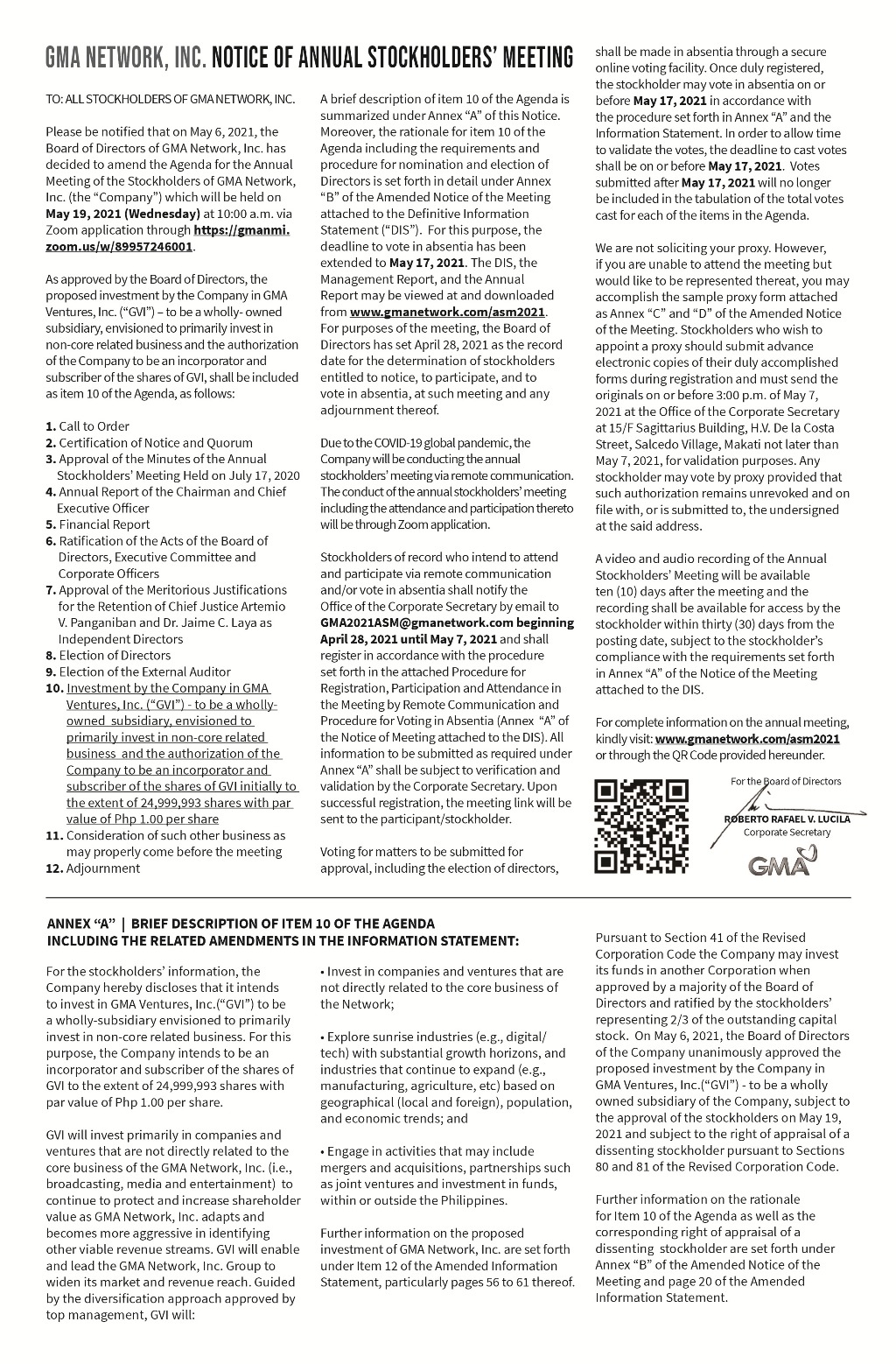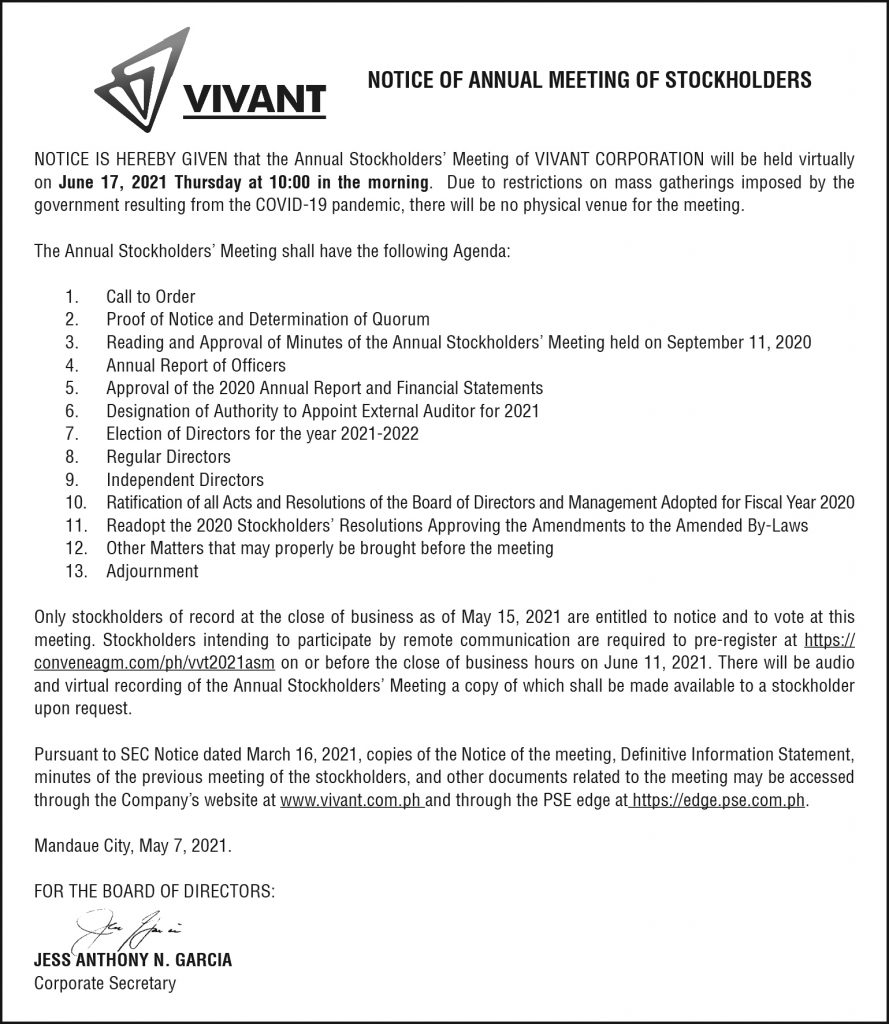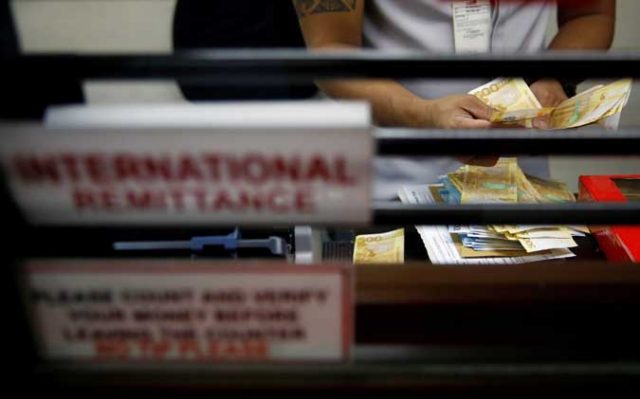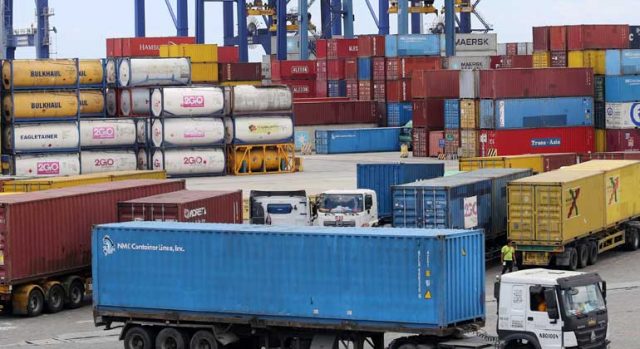Remittances up for 2nd straight month
By Luz Wendy T. Noble, Reporter
CASH REMITTANCES from overseas Filipino workers (OFWs) rose by 4.9% in March as many host countries start to further ease pandemic-related restrictions as coronavirus disease 2019 (COVID-19) infections drop.
This helped push first-quarter remittances by 2.6% higher at $7.593 billion, data from the central bank showed on Monday.
Cash remittances stood at $2.514 billion in March, higher than the $2.397 billion a year earlier. The month’s remittances went up by 1.53% from the $2.476 billion in February.
“This is the second consecutive month that remittances were higher than last year’s levels, reflecting mainly the easing of travel restrictions, re-opening of borders to foreign workers, and progress in COVID-19 vaccine rollout in many advanced countries,” the Bangko Sentral ng Pilipinas (BSP) said in a statement.
The March growth rate is also a reversal from the 4.7% contraction seen in the same month in 2020, when countries around the world began lockdowns to curb the spike in COVID-19 cases.
According to the BSP, money sent home by land-based OFWs grew by 5% to $1.948 billion in March, while seafarers remitted $566 million, up 4.5% year on year.
Analysts said the Filipino frontline workers abroad helped drive remittances higher, as they sent more money home to help their families.
“OFWs who are medical professionals in host countries have supported the continued growth in OFW remittances since the pandemic,” Rizal Commercial Banking Corp. Chief Economist Michael L. Ricafort said in a Viber message.
Mr. Ricafort said low base effect from the decline last year also supported the growth rate.
Essential workers are not limited to the healthcare sector but also include skilled employees that are much needed in economic recovery, Asian Institute of Management economist John Paolo R. Rivera said.
“People in construction, electricians, housekeeping, and other skilled labor were also in demand abroad to help reboot the economies of their host economies. Some professionals and highly skilled workers have also been deployed when economies started to open slowly,” he said in a Viber message.
In March, the United States remained the country’s top source for remittances, followed by Singapore, Saudi Arabia, Japan, the United Kingdom, the United Arab Emirates, Canada, Qatar, Taiwan, and Malaysia. Together, they accounted for 78.2% of the total cash remittances.
Personal remittances — which include inflows in kind — jumped by 5.6% to $2.801 billion from $2.652 billion in March 2020. In the first three months, personal remittances increased by 2.9% to $8.454 billion.
Remittances are crucial in supporting household spending which makes up 70% of the country’s economy. Last year, remittance inflows dropped by 0.8% to $29.903 billion, the first annual decline since 2001 as some OFWs lost their jobs amid the global health crisis.
Remittances will likely continue to grow in the next few months given migrant workers’ tendency to become altruistic in times of need, Mr. Ricafort said.
“Tighter quarantine restrictions in NCR (National Capital Region) Plus since the latter part of March amid new record high COVID-19 local cases recently could also increase the need to send more remittances to assist adversely affected dependents in the country,” he said.
Tighter quarantine restrictions in Metro Manila and nearby provinces were implemented since late March until early May. The areas are currently under a more relaxed general community quarantine (GCQ) with “heightened restrictions” until the end of May.
For Mr. Rivera, the remittance outlook is still clouded by the COVID-19 situation in the Philippines and overseas.
“If the Philippines will continue to record existence of new variants, this may hamper further deployment of Filipinos coming directly from the Philippines. Also, rising new cases abroad also threatens deployment,” Mr. Rivera said.
He cited Hong Kong, a host country for many domestic helpers, which imposed a two-week travel ban for flights from the Philippines due to the recent surge in COVID-19 cases.
COVID-19 cases in the Philippines surpassed the one million mark in March. The Health department reported 5,979 new infections on Monday, with active cases currently at 54,235.
The country has already recorded COVID-19 cases with the “double mutant” Indian variant as well as other variants deemed to be more infectious by health authorities.
The BSP is hopeful that remittances will recover this year with a growth of 4%.
Government urged to reassess strategy of fiscal prudence
THE GOVERNMENT should reconsider its strategy of fiscal prudence and put less importance on the rising debt level, while ramping up spending for its pandemic response and to spur economic recovery, analysts said.
“The fiscal prudence is evident in the data on government debt data. But this is not a time for prudence. This is the time to take advantage of the fiscal space that a government has,” Steven Cochrane, chief Asia-Pacific economist at Moody’s Analytics, said in an e-mail to BusinessWorld.
The Philippine economy shrank by 4.2% in the first quarter, while the debt stock jumped 27% year on year to P10.774 trillion as of end-March. This pushed the debt-to-gross domestic product (GDP) ratio to 60.4%, a little beyond the 60% considered by ratings agencies as manageable debt level.
While the debt-to-GDP ratio inched up, Mr. Cochrane said this was still below the emerging market average as of end-2020 and rose at a slower pace than other emerging countries.
“The Philippines’ moderate exposure to debt — as measured by the debt-to-GDP ratio — at this time means that the Philippines has the capability to tap resources to both deliver vaccines and support suffering industries,” Mr. Cochrane said.
“Government can best focus its fiscal support for the economy during this pandemic recovery by acquiring and distributing vaccines in a rapid and efficient manner, and by supporting the industries, small enterprises and workers most hurt by the pandemic so that they can quickly recover when quarantines are lifted,” he added.
ING Bank NV-Manila Senior Economist Nicholas Antonio T. Mapa said “fiscal prudence” should be reassessed as the economy continues to shrink while debt increases.
“Although the Philippines continues to safeguard its fiscal sustainability by having the majority of its debt with longer tenors and fixed rates, fiscal authorities are likely not comfortable as the ‘deficit in the room’ threatens to grow even more,” Mr. Mapa said in a note.
The first-quarter budget deficit surged more than four times to P321.5 billion from the P86.2-billion shortfall in the same period of 2020.
“Apparently, the strategy to withhold spending in a bid to limit the rise of the debt-to-GDP ratio has not worked out so well and perhaps we need a change in strategy,” Mr. Mapa said.
He noted backers of a “bazooka-type recovery plan” admit this would cause the deficit to further balloon, but its impact on economic growth would be worth it.
“And although this strategy may have its skeptics, what we are sure of is that rising debt-to-GDP ratios and below-average GDP performance will surely get the attention of the Big-3 and leave the Philippines susceptible to a revision of the country’s outlook or even a downright credit rating downgrade if the ratio stays above 60% for an extended period of time. The deficit is in the room and will likely need to be addressed effectively, possibly with a change in strategy at the soonest,” Mr. Mapa said.
The government projects the budget deficit to hit 8.9% of the economy this year. Finance Secretary Carlos G. Dominguez, III said they are eyeing to bring back the fiscal deficit to the pre-pandemic levels of 3.5% to 4% by 2022, mainly through revenues and a strong economic rebound.
The government is still hoping for GDP to grow by 6.5% to 7.5% this year, although analysts have warned of uncertainties due to the infection surge and the slow vaccination pace.
“The economy will have to recover before the debt ratio can improve significantly,” Mr. Cochrane said. — Luz Wendy T. Noble
Export industry seeks more gov’t support for promotion
By Jenina P. Ibañez, Reporter
THE EXPORT INDUSTRY is asking for more funding for government promotion and product development initiatives to back the sector’s recovery from the coronavirus pandemic.
George T. Barcelon, the newly appointed chairman of the Philippine Exporters Confederation, Inc. (Philexport), said the Department of Trade and Industry (DTI) needs bigger funding to support such activities.
“The (DTI) budget is so small,” he said in a phone interview on Monday. The DTI and its attached agencies were allocated around P21 billion from the national budget for 2021.
Mr. Barcelon said the Trade department can assist product development and use data to identify which sectors to promote.
“(DTI should) really encourage the domestic manufacturers. Manufacturers making products for the domestic market, they can always export their products,” Mr. Barcelon said. “(They should) encourage our various sectors to join international export shows.”
Merchandise exports in March jumped 31.6% to $6.68 billion compared with the same month last year, data from the Philippine Statistics Authority showed. Export growth that month was the fastest in over a decade, or since the 46.8% growth in September 2010.
This hints at some improvement after goods exports fell 10.1% to $63.8 billion in 2020.
Mr. Barcelon said the country continues to lag behind other Southeast Asian economies.
“We think that we have the advantage in terms of creativity, innovation, but we need to support our exporters,” he said.
Financing for smaller exporters continues to be a challenge, he said.
Applications for loans from the Small Business Corp. (SB Corp.) have been sluggish, as the government agency tightened lending standards. SB Corp. has been given additional funds to assist businesses affected by the pandemic.
Fewer small businesses have been applying for the loans amid low business confidence, Trade Secretary Ramon M. Lopez said.
Mr. Barcelon said it is difficult for the Philippines to penetrate the export market as it competes against Thailand, Indonesia, China, and Cambodia.
“But we do have a name: Filipino products — houseware, house decor. But ang problema, sa competitive na presyo nahihirapan tayo (Our problem is we have difficulty in pricing our products competitively),” Mr. Barcelon said. “It’s a matter of cost of doing business.”
Issues surrounding the export sector are varied, ranging from bureaucratic bottlenecks to employee training, he said.
In the meantime, he said that the DTI can select agriculture and manufacturing products to promote to specific markets.
“The (economies of) developed countries are just starting to pick up, so we should be able to help our exporters to rebound.”
PEZA plans restructuring to expand regional presence
THE PHILIPPINE Economic Zone Authority (PEZA) will be restructured to create more regional presence, its top official said.
“We’re coming up with a new structure because we want to decentralize and regionalize our services,” PEZA Director-General Charito B. Plaza said in an online interview.
Regions with more ecozones will have their own offices, she said. The agency is eyeing approval of the employee compensation classifications under the new structure before the end of the year.
The investment promotion agency has been pushing for the development of more ecozones in the countryside, working with the Union of Local Authorities of the Philippines to identify areas they could convert into ecozones.
“We based it on the land potential and the resources of the plan. We don’t have to destroy land — if it’s an agricultural land, we call it agro-industrial economic zone. If it’s a fishing ground, we have the aquamarine economic zone,” she said.
PEZA has also been planning to transform its public ecozones into townships by building commercial and housing facilities for employees and investors.
While it has been backing countryside investment, the agency asked President Rodrigo R. Duterte to lift a ban on the creation of new economic zones in Metro Manila. The moratorium was declared in 2019 to promote investment in the provinces.
PEZA-approved investment pledges increased by almost 54% to P25.82 billion in the first quarter of 2021 after coming off a low base last year. The 57 projects could create more than 5,600 jobs, PEZA said. — Jenina P. Ibañez
DDMP REIT income climbs nearly 12% in first quarter
LISTED DDMP REIT, Inc. (DDMPR), the real estate investment trust of DoubleDragon Properties Corp., saw an 11.7% profit growth to P399.65 million in the first three months of the year from P357.8 million year on year.
In a regulatory filing on Monday, the company said its rental income also grew to P508.59 million, 1.82% higher than the P499.52 million it generated in the same period last year.
“The company’s portfolio is 97.23% leased out and continues to remain stable,” DDMPR said.
DDMPR also reported a gross amount of P358.97 million of cash dividend, where each shareholder as of the record date of May 28 will be receiving P0.020136 per share.
The company has set June 10 as the payment date.
“We are pleased to conduct the second consecutive cash dividend declared to the shareholders of DDMP REIT this quarter, this time covering the profits that DDMP REIT generated during the first quarter of 2021,” DDMPR Chairman Edgar “Injap” Sia II said.
DDMPR said it looks forward to availing of the tax benefits from the REIT Law of the Philippines starting the next dividend declaration, which the company said: “will create a significant positive impact on the amount of cash dividends available for declaration to the shareholders.”
Quarter on quarter, total assets of the company went up by 0.91% to P45.77 billion from P45.35 billion, while its total equity also increased by 1.13% to P35.92 billion from P35.52 billion quarter on quarter.
Shares of DDMPR at the local bourse closed unchanged on Monday at P1.95 each. — Keren Concepcion G. Valmonte
MerryMart reports P48M net income in 2020, P9.46M in Q1
MERRYMART Consumer Corp. on Monday said it saw a 72.23% growth in consolidated net income to P48.24 million last year from P28.01 million in the previous year, while consolidated revenues grew by 33.74% to P3.47 billion.
The company said it opened 22 new stores last year, hitting its goal of 25 branches at the end of 2020. It currently has 34 operational branches across the Philippines.
“As we open new branches our revenues grow exponentially, although it may take a few months for a new store to reach optimal levels and become fully efficient we see these new branches as newly planted cuttings which will start to flourish once settled,” Edgar “Injap” J. Sia II, chairman of MerryMart, said in a statement.
MerryMart aims to open 66 more branches nationwide to reach a total of 100 stores before the year ends.
Most of the new branches will be in the company’s smallest format store, MerryMart 3 in 1 household essential store, which features basic grocery items, personal care products, and a pharmacy.
For the first three months of the year, the company’s consolidated net income bumped up by 13.28% to P9.46 million from P8.35 million year on year.
MerryMart’s consolidated revenues for the quarter also rose by 15.17% to P915.47 million from P794.91 million seen in the same period in 2020.
“2021 will be an important year for MerryMart Group as the team is simultaneously working intensely on various aspects of the business, from further enhancing the logistics distribution system, streamlining the operational processes, activating the new wholesale division, embarking in innovative technology ventures,” Mr. Sia said.
The company launched “dark groceries” in partnership with online delivery service Foodpanda, which are said to be “invisible” grocers and it caters only to online deliveries within the branch’s vicinity.
In April, MerryMart said it is also launching MBOX smart lockers, the first business under its consumer technology portfolio.
“MerryMart will continue to keep its eyes open for M&A (mergers and acquisition) opportunities in both the grocery and pharmacy space that would accelerate its growth,” Mr. Sia said.
On Monday, shares of MerryMart at the stock exchange went down by 7.99% or 35 centavos to close at P4.03 each. — Keren Concepcion G. Valmonte
Robinsons Land unit files registration statement for REIT IPO
ROBINSONS Land, Corp.’s (the sponsor) subsidiary Robinsons Realty and Management Corp. has submitted a registration statement for a real estate investment trust (REIT) initial public offering (IPO) to the Securities and Exchange Commission (SEC) on Monday.
The company said the subsidiary’s articles of incorporation have also been amended to update its name to RL Commercial REIT, Inc. (RLC REIT), which is now pending approval with the SEC.
“Subject to receipt of regulatory approvals and market conditions, RLC REIT plans to offer secondary shares of up to 3,342,864,000 common shares under a firm offer, with an over allotment option of up to 305,103,000 common shares, at an offer price of up to P7.31 per share,” Robinsons Land said in a statement.
It is anticipated to raise gross proceeds worth nearly P26.67 billion should the overallotment option is exercised.
“Net proceeds will be used by the sponsor to fund its real estate projects in the country in accordance with its reinvestment plan,” Robinsons Land said.
The initial portfolio of RLC REIT includes 14 PEZA-accredited (Philippine Economic Zone Authority) assets, spanning over 400,000 square meters of gross leasable area across Metro Manila business districts and commercial hubs beyond the region.
Included assets are the following: Exxa-Zeta Towers in Quezon City, Makati City’s Robinsons Summit Center, Robinsons Cyberscape Alpha and Robinsons Cyberscape Beta in Pasig City, and Mandaluyong City’s Robinsons Cybergate Center 2 and 3, among others.
BPI Capital Corp. and UBS AG Singapore Branch have been tapped as joint global coordinators, lead managers, and joint bookrunners.
UBS AG Singapore will also be joined by CLSA Ltd. and Merrill Lynch (Singapore) Pte. Ltd. to serve as the international bookrunners.
Robinsons Land assigned BPI Capital as the lead local underwriter, while China Bank Capital Corp., First Metro Investment Corp., and PNB Capital and Investment Corp. will be the local underwriters for the proposed offering.
Shares of Robinsons Land at the stock exchange went up by 0.75% or 12 centavos on Monday to close at P16.12. — Keren Concepcion G. Valmonte
Emperador allots P1.5 billion capex for global expansion

EMPERADOR, Inc. has allocated P1.5 billion for its capital expenditures (capex) this year, a 50% jump from last year’s P1-billion budget to “accelerate” its global expansion plans.
“We have decided this year to invest ahead so that our growth plan can be sustained,” Emperador President and Chief Executive Officer Winston S. Co said during the company’s virtual stockholders meeting on Monday.
The company is “maximizing the potential and opportunity for each market depending on the consumer and preferences.”
“As a global company, we constantly adapt to changing consumer behavior especially in a challenging and difficult environment,” Mr. Co said.
He explained that consumer behavior varies according to their region or country “depending on how liquor is positioned or perceived as either an essential or non-essential product.”
Its brandy and whisky products are available in over 100 countries across six continents.
Last year, the company saw an 18% growth in earnings to owners to P8 billion on the back of its international business despite the coronavirus disease 2019 (COVID-19) pandemic.
“In the Americas, particularly the US, and in Europe, particularly the UK, where liquor is an essential product, sales are doing very well,” Mr. Co said.
“In contrast, there have been liquor restrictions in certain areas in the Philippines over an extended period of time,” Mr. Co said.
For the first quarter this year, the company’s net income to owners improved by 43% year on year to P2.1 billion from P1.46 billion, while its topline went up by 13% to P12.1 billion from P10.66 billion after seeing a “continued robust performance” from its global business.
The listed whisky and brandy manufacturer is expecting the easing of pandemic restrictions this year due to vaccinations, which Mr. Co expects to lead to increased air travel and “some form of normalcy.”
On Monday, Emperador shares at the stock market improved by 1.60% or 15 centavos, closing at P9.50 each. — Keren Concepcion G. Valmonte
Globe signs $100-M loan with Bank of China
GLOBE Telecom, Inc. announced on Monday that it signed a term loan facility with Bank of China (Hong Kong) Ltd. for $100 million.
“The loan will be used to finance the company’s capital expenditures (capex),” Globe said in a disclosure to the stock exchange on Monday.
Globe has said it expects to spend P70 billion this year. The company already spent more than P19 billion in the first three months of the year.
“Around 91% of the investment went to data-related requirements to support the fast-growing data usage and provide superior data customer experience,” the company said.
Among the priorities this year are the company’s “aggressive cell site builds, upgrade of all its sites to fourth generation/long-term evolution technology (4G/LTE), and fast-tracking the fiberization of Filipino homes nationwide,” Globe noted.
Globe’s attributable net income reached P7.31 billion in the first three months of the year, up 11% from P6.58 billion in the same period in 2020.
Its total revenues for the first quarter rose 4% to P42.85 billion from P41.19 billion in the same period last year.
Service revenues — which include mobile, home broadband, corporate data, and fixed line voice — increased 2.5% to P37.81 billion from P36.88 billion previously.
Globe Telecom shares closed 1.10% higher at P1,831 apiece on Monday. — Arjay L. Balinbin
Converge income jumps to nearly P2B; targets to grow subscriber base to 1.7M
CONVERGE ICT Solutions, Inc.’s attributable net income for the first three months of the year nearly tripled to P1.55 billion from P573.60 million in the same period last year, owing primarily to an increase in subscribers as the pandemic crisis continues.
Total revenues, which include contributions from residential and enterprise, increased 83.2% to P5.55 billion in the first quarter from P3.03 billion in the same period in 2020, the company said in a disclosure to the stock exchange on Monday.
Broken down, revenue from the residential business more than doubled to P4.80 billion from P2.29 billion, while the enterprise segment saw a slight increase of 2.2% to P750 million from P734 million previously.
Converge said its residential subscribers increased to almost 1.2 million as of March 31 this year from 615,466 as of March 31, 2020.
“Converge captured 48% market share of fixed broadband net adds amongst the three largest broadband operators in the Philippines, representing an increase in fixed broadband market share from 19% in March 2020 to 27% in March 2021,” the listed fiber internet provider said.
The company also said around 95% of its new subscribers in the first quarter of the year were first-time fixed broadband users.
At an online briefing on Monday, Converge Chief Financial Office Advisor Matthias Vukovich said: “We are looking to grow our subscriber base to… 1.7 million at the end of the year.”
“We are very much on track to reach that goal,” he added.
Converge ICT shares closed 1.51% higher at P18.78 apiece on Monday. — Arjay L. Balinbin












